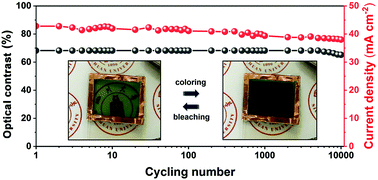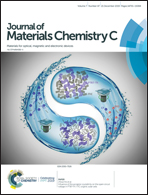Constructing spraying-processed complementary smart windows via electrochromic materials with hierarchical nanostructures†
Abstract
Nanostructured electrochromic materials are commonly explored in electrochromic devices for high coloration efficiency, fast switching speed, and long cycling lifetime, while complementary electrochromic devices comprising anodic and cathodic coloring materials are efficient in achieving large optical modulation. However, there is limited success in constructing the complementary electrochromic devices with nanostructured electrochromic materials for a combination of fast switching speed, high optical contrast, adequate cycling stability, and low manufacturing cost. Herein, we present a facile and efficient strategy to construct low cost complementary smart windows by assembling spraying-processed films of two nanostructured electrochromic materials with similar electrochromic transitions under opposite redox conditions. The resulting device exhibits excellent electrochromic performance, including significant optical modulation of 68% at 660 nm, fast switching speed of 0.5/0.9 s for the coloration and bleaching processes, high coloration efficiency of 520 cm2 C−1 and ultra-high cycling stability over 10 000 cycles. In addition, these nanostructured electrochromic materials are core–shell halloysite nanotube (HNT)@inherently conducting polymer (ICP) nanocomposites prepared via a facile chemical oxidation polymerization by using cheap and naturally abundant HNTs and commercially available ICP monomers. The related preparation processes (e.g., spray coating) are low-cost and can be conducted under ambient conditions. All these allow the developed materials and smart windows to be readily scaled up for mass production. The developed novel, facile and economical approach in this work for fabricating nanostructured electrochromic materials and spray-coated smart windows with electrochromic hierarchical nanostructures shows great potential applications in a variety of engineering and bioengineering areas.



 Please wait while we load your content...
Please wait while we load your content...